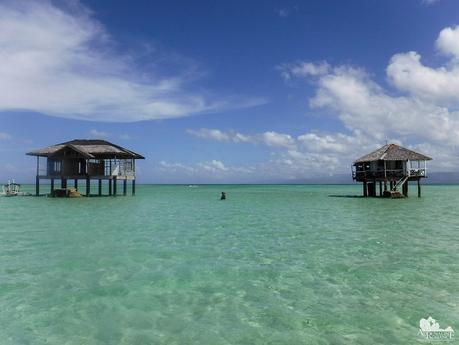
While other countries have to endure strong blizzards and deadly polar vortices, Filipinos are truly blessed with a country that is awash with warm, tropical weather. And where there’s glorious sunny weather, one can’t help but think of enjoying on the shores of sandy beaches. Now, what if we told you that there’s a place where you can enjoy 7 kilometers of pristine sand, surrounded by turquoise waters, while being served with yummy seafood? Yes, that’s all here at Manjuyod Sandbar—the so-called Maldives of the Philippines—in Bais, Negros Oriental.
I have rediscovered my childhood passion of scale model building after a long 10-year hiatus. As I searched for local hobby shops around the Visayas, I found a well-stocked one named Fred’s Ultimate Hobby Shop in Dumaguete, Negros Oriental. When I told Sweetie that I want to pay the shop a visit and buy some kits from my extra money, she and Alexa decided to come along. In order not to waste the opportunity, we decided to tour around Dumaguete. Our plan included a trip to Manjuyod Sandbar, located off the coast of Bais.
We arrived Friday noon at Dumaguete where we visited Fred’s Ultimate Hobby Shop. The 8-hour land trip from Cebu drained us, however, so we decided to just stay in the hotel and have a long sleep.
We woke up early the next day before sunrise and headed to the Dumaguete bus terminal. After a one-hour bus ride, we arrived at Bais City where our contact Rey was waiting for us. Our friend and fellow blogger Ferna of Everywhere With Ferna recommended Rey to us.
Since Rey was personally unavailable due to his Sunday church service, he left us in the capable hands of his dad. We took a 20-minute tricycle ride to reach our jump-off point at the village of Canibol, Bais.
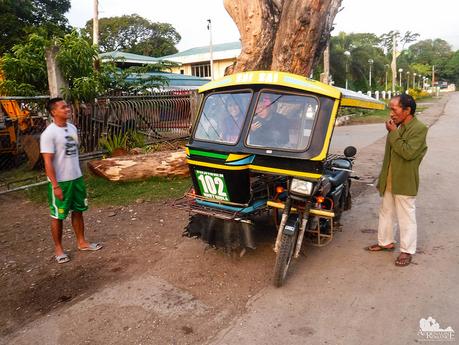
After a relatively smooth ride across cornfields, we arrived at Canibol, Bais, which served as our staging point to Manjuyod Sandbar. It was such a small, quiet village. If it were not for an old woman sweeping dead leaves off her property, we swear we would have visited a ghost town. Rey’s dad told us to wait a moment while he prepares the boat and gathers his team. Thus, we had some time to survey the place. Because Canibol was situated in a small but sharply curved bay, we were able to see the majestic mountains of mainland Negros.
With dozens of pump boats run aground, Canibol is essentially a fishing village. It was only recently when the village became a tourist hub spot by becoming an alternative jump-off point for those who want to visit Manjuyod Sandbar.
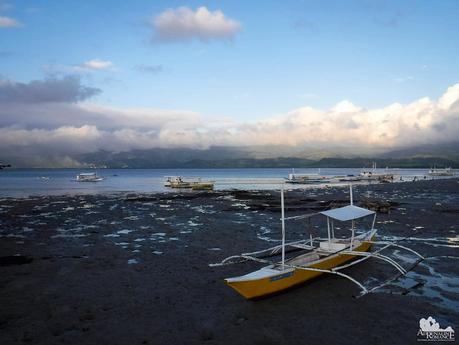
Half an hour later, our boatmen appeared, carrying extra gasoline and—breakfast? Oh, yes! Breakfast was included in this tour, which was perfect considering we haven’t eaten anything since we left the hotel!
Since it was still low tide and the boat was docked far from shore, we walked a little bit on the mudflats. The sticky mud threatened to suck our flip-flops.
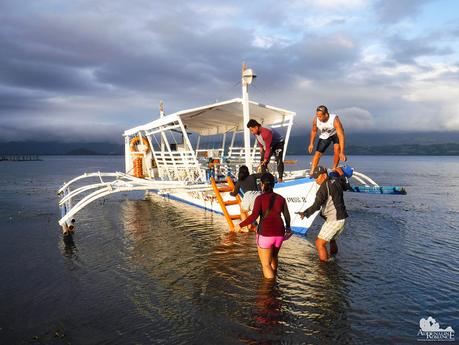
The engine sputtered to life, and our hearts quaked with excitement. We were now on our way to what they call the “Maldives of the Philippines.”
We passed by this small island in the middle of the bay. It was amazing to find the shores of this small island densely populated.
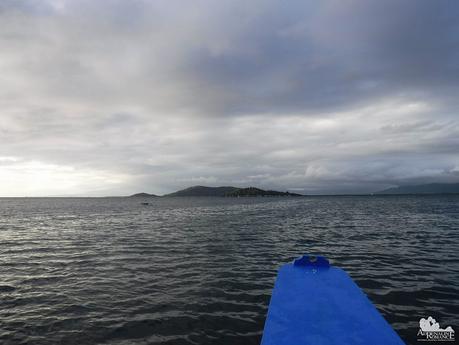
If it were not for the clouds, we would have seen the sunrise. Nevertheless, it was a beautiful sight. The sunbeams shining through the clouds was like a promise. It’s like Mother Nature telling us that there’s something good out there.
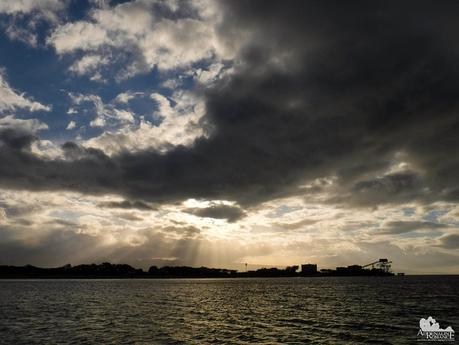
In less than 30 minutes, we could see the iconic stilt structures that Manjuyod Sandbar is known for. The man-made structures stood out starkly on the horizon. They look strangely out of place in the sereneness of the sea.
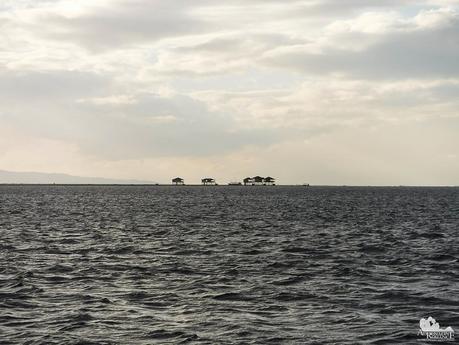
Because it was still early morning, we sailed beyond Manjuyod Sandbar. More than ever, we wanted to see this place’s other natural wonder—the famed pods of jolly dolphins in their natural habitat.
Unfortunately, the graceful marine mammals didn’t show up due to relatively rough seas. Our boatmen, who were as disappointed as we were, said that the dolphins only come up during calm weather.
Nevertheless, we kept our hopes up and was on a sharp lookout for telltale signs of tails or dorsal fins. No such luck, but such is Mother Nature. She is unpredictable, and we have learned to accept her unpredictability.
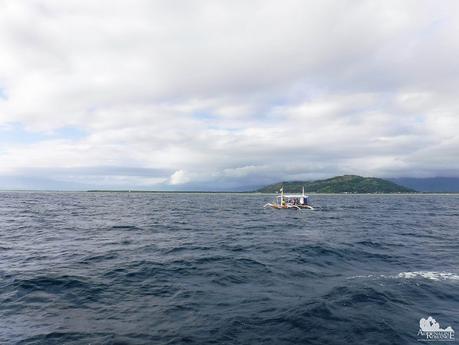
Unable to find the dolphins, we headed back to the sandbar. As we cruised along its periphery, we saw locals walking along the flats, hunting for edible shellfish, crabs, and mollusks before the high tide covers these critters. Seabirds competed with humans in a communal hunt.
It was an eerie sight of people walking on a patch of land surrounded by deep water.
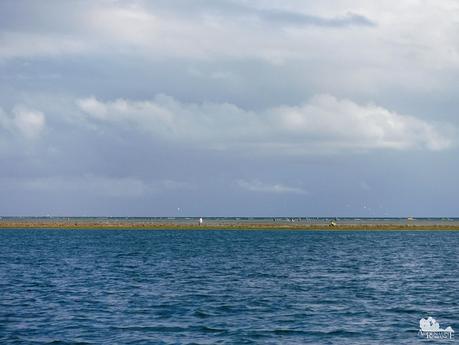
In a few minutes, we arrived at the beautiful Manjuyod Sandbar. It was still early morning, and the place was mostly devoid of people. Just like the way we like it!
For a popular tourist spot in this part of Negros, Manjuyod Sandbar is amazingly devoid of rubbish. Except for the man-made structures, it’s as pristine as when Mother Nature conceived it. We discovered later that the LGU constantly monitors the sandbar. It imposes huge fines for those caught littering. That’s the way it should be!
Setting foot on the sandbar is absolutely free. But those stilt houses are actually cottages for rent, built permanently into the sand. To prevent non-paying visitors from using the cottage, the stairs leading to it are raised up.
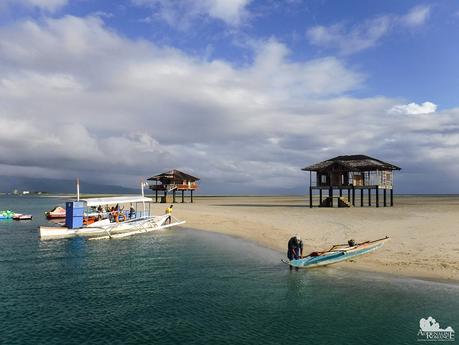
After eating a warm breakfast of puto (sticky rice), mango, and sikwate (native hot chocolate), it was time to explore the sandbar. As we went beyond the stilt cottages, it was clear that Manjuyod Sandbar is definitely more than just your usual teeny-tiny sandbar that you see in your usual island hopping tours. It is so vast that it actually resembles a desert! In fact, it is considered to be one of the largest sandbars in the Philippines.
From our vantage point, it seems like Manjuyod Sandbar is connected to the mainland. Thus, in theory, you can walk from Barangay Canibol to here although that would take a long hike.
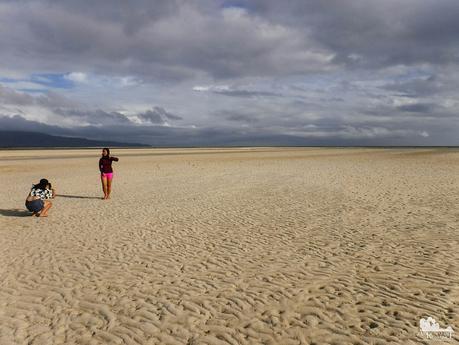
If not for the sea surrounding us and the refreshing sea breeze, we swear we could be in the Sahara! As you can see, you don’t have to fight for beach space. Hahaha!
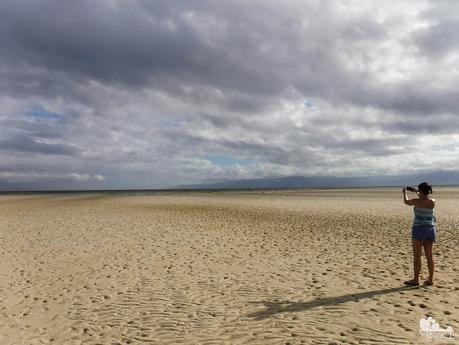
The daily ebbing and rising tides, the blowing wind, and the rippling currents left interesting wavy patterns in the sand. Mother Nature is a complex artist.
Speaking of sand, the sand in Manjuyod Sandbar easily “competes” with some of the finest sandbars we’ve visited. The sand feels soft and powdery, especially near the shore. We can actually feel our feet sink with every step. Farther through the “desert” though, the sand is far firmer.

But not all the patterns were made by waves and wind. Small star-shaped prints marked the movement of hundreds of small starfishes who are probably returning to the sea. Those small holes are burrows of small crabs trying to find refuge from predators (usually seabirds) and the stomping of human feet.
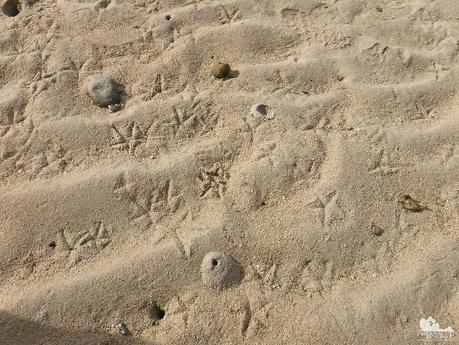
We also found this gigantic sea cucumber desperately slithering back to the sea. Sea cucumbers occupy an important niche at the bottom of the marine food chain. They recycle nutrients and break down organic matter.
Sea cucumbers are also used for human consumption in various countries around the world. Because they taste bland, they need to be seasoned heavily. The Chinese consider them as aphrodisiacs owing to their penis-like shape.
This time though, I didn’t make it into something I can chew on. I picked up the poor creature and tossed it back to sea. Be free, cucumber!
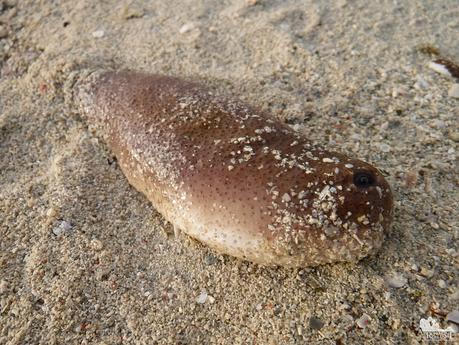
Seabirds flew in circles and made steep dives as they plucked out their breakfast from the sea.
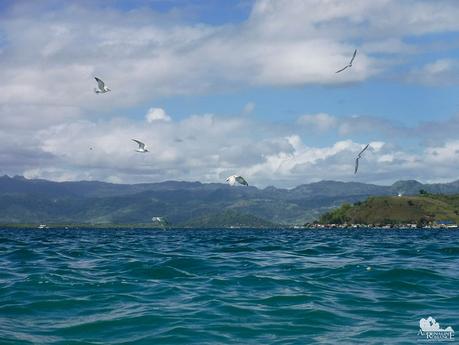
Of course, no visit to Manjuyod Sandbar is complete without frolicking in its clear, cool waters. Crawling along the sand as the tide rushes easily melts all stress and troubles away.
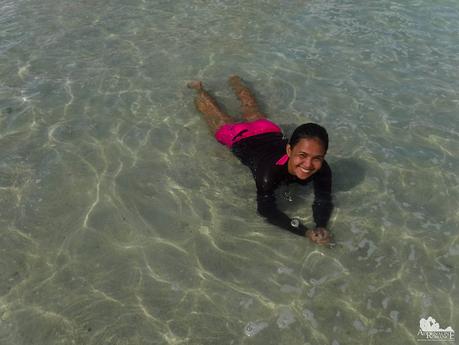
Business in the Middle of the Sea
As the day wore on and tourists started coming in, enterprising locals arrived to make a few bucks. Some sell “specialized” products. This boat came in with a load full of fresh coconuts.
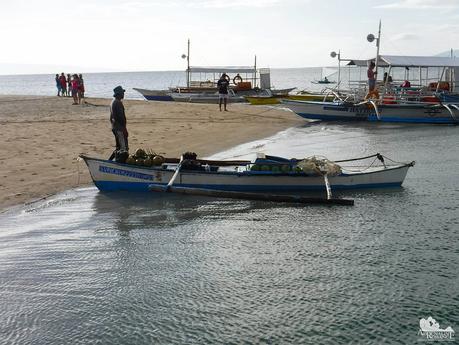
There is no sari-sari store, restaurant, or eatery in Manjuyod Sandbar. So what will you do if you somehow failed to buy your snacks? Or you want a cold drink? Or you need some junk food?
Never fear, the sari-sari boat will actually come to you! Prices are a bit steep although that is completely understandable.
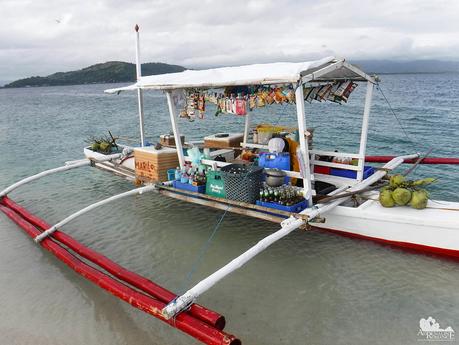
The lack of high-tech jetskis and speedboats did not deter locals from improvising fun rides. They use small but fast pumpboats, they tow inflatable boats filled with shrieking tourists.
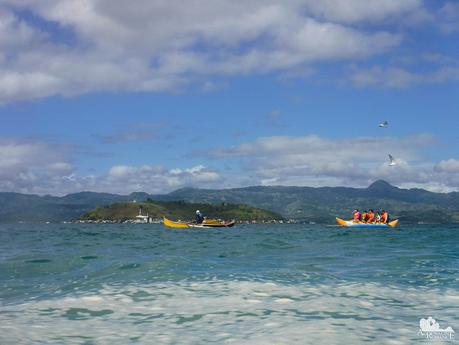
Let’s Talk About Seafood
One of the best experiences we have during our sojourn in Manjuyod sandbar was that we got to taste different kinds of seafood! From the common to the weird, from the normal to the yucky stuff, it was a smorgasbord of marine delights!
Large squids, freshly caught from the sea, were on full display. Do you want them grilled, stuffed, or cooked adobo style?
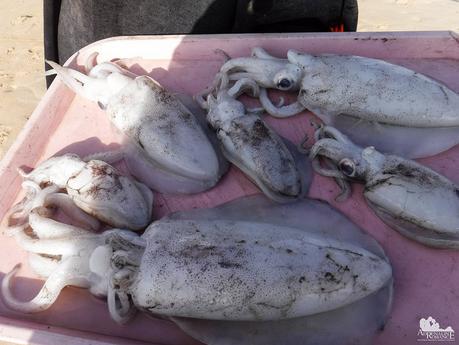
Seashells like these are roasted and grilled. Sometimes, the meat is tough, but they taste juicy and delicious. But you better have a pin or needle handy; sometimes, you need to spear through the meat and pull it out.

Sea urchins are popular seafood here. But you need to crack their tests (hard shell) to get to their edible gonads. The meat has a strong taste of sea, which is palatable for me. Living in a country surrounded by the ocean, the taste of sea urchin is an acquired taste.
Sea urchin is often served as a delicacy in many parts of the world. I have yet to try uni—sea urchin sushi!
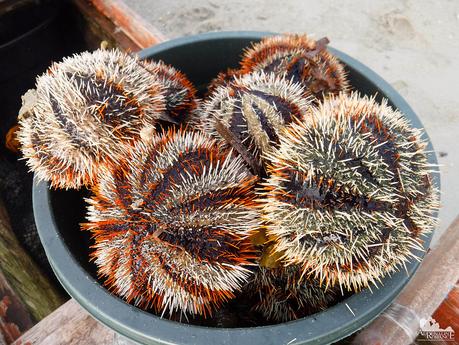
Sweetie and I got curious about these huge fan-shaped pen shells. In life, their pointed ends are usually anchored in mud or sand. Their shells have a long teardrop shape and are fragile. The interior is iridescent, making them popular materials for shellcraft.
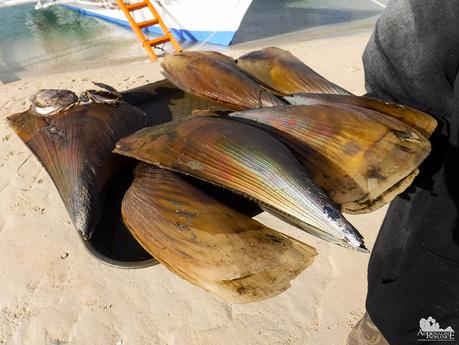
But we’re here for a more insidious purpose. LOL! It turns out that the meat of the pen shell is edible! We chose a big one for lunch and watched the vendor scoop out the meat. It looks like…..an alien?
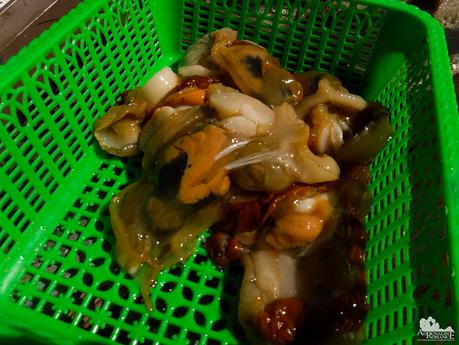
Although the meat can be eaten raw, we decided to have it steamed as we don’t have any idea how our guts would react to this monstrosity. But where shall we cook it? Well, we need not worry. The vendor’s boat was actually THE kitchen!
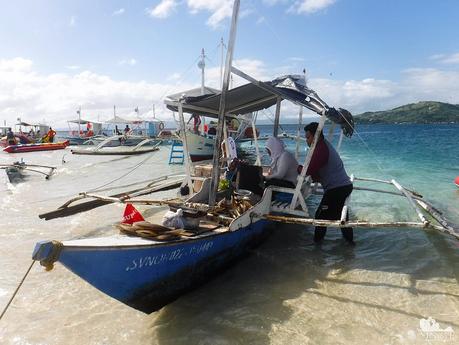
At noon, we succumbed to the rumblings of our stomach. Great timing too as the vendor approached our boat, handing us over a steaming mound of pen shell meat. The large shell made an ideal serving plate.
Is it delicious? Well, it depends on the part you’re eating. For example, the yellow-brown parts were leathery and don’t offer much taste. The white parts were tasty, similar to fish balls, a popular street food here. That large orange ball sac is incredibly savory although it makes a mess when you eat it.
Ah, don’t you just love it that the sea holds a lot of surprises? Even in food?
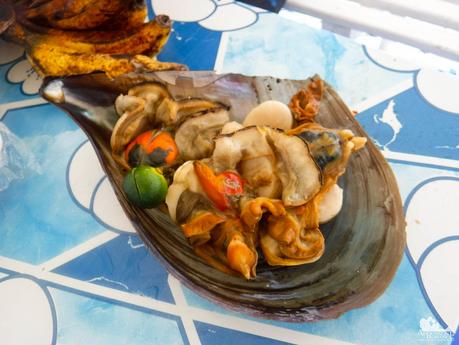
Our tour included lunch that our boatmen prepared. We had grilled pork, shrimp fried in a sweet sauce, and a spindly shellfish locally called saang. We ate it together with the pen shell meat.
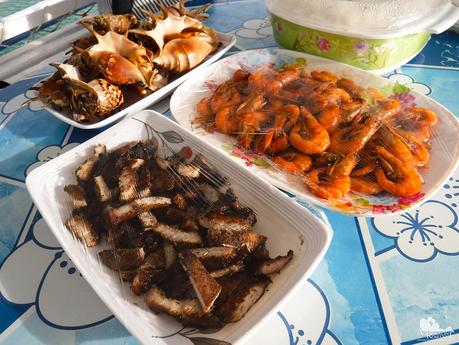
The tide mirrored the sun’s rise to its zenith. Thus, at noon, the sandbar was completely submerged in crystal clear water. Don’t worry though, the water only reaches your knees at its highest.

White sand. Aquamarine water. Amazing seascapes. Can Manjuyod Sandbar be called the “Maldives of the Philippines?” No! It is more than that. It is home.
Contact Details
For a trip to Manjuyod sandbar, get in touch with Rey at 0915-617-6771.
Budget*
- Php 45 per person – non-aircon bus fare from Dumaguete Ceres bus terminal to Bais City (rate applies on the return trip)
- Php 400 per tricycle – round trip tricycle fare from Bais City to Canibol wharf
- Php 3,500 per boat (includes dolphin watching, day trip at Manjuyod Sandbar, simple lunch)
* Rates can change without prior notice. Note that we didn’t include the budget for meals, snacks, and personal expenses as you may have different sharing schemes or preferences.
Tips
1. You may also contact the following tourism offices for assistance, especially if you want to rent the stilt cottages or stay overnight:
Manjuyod Tourism Office
- Landline: (6335) 404-1136
- Cellphone: 0919-488-2950
- Email: [email protected]
Bais Tourism Office
- Landlines: (6335) 402-8338
- Cellphone: 0917-300-5945 / 0918-265-0474
- Email: [email protected]
2. We recommend starting your island hopping adventure early in the morning where there aren’t many tourists. The charm, serenity, and the feeling of oneness with nature disappears when there are too many visitors around.
3. Our package already included lunch, so we are assuming that yours will come with lunch too if you book with Rey. However, just to be safe, it’s better to buy and bring your own food, drinks, and supplies in Dumaguete or Bais City.
4. You can buy snacks and drinks at the sari-sari boat that usually comes along the sandbar. However, we are not entirely certain when the boat will arrive or if the boat will arrive during weekdays or low season. Note too that the items sold will probably be more expensive than those you will find inland.
5. It is tempting to try out the various seafood that the fishermen will offer you. Before you do, however, make sure you are not allergic to seafood. Make sure that your stomach is not sensitive to seafood; the last thing you want is to have a bout of diarrhea during your trip. Bring along some anti-diarrheal drugs just tobe sure.
6. Be careful when swimming beyond the sandbar where the water is deep. Don’t swim alone, or ask your boatman or a companion to keep an eye on you.
7. Pack light but bring the following:
- water (at least two liters)
- sandals
- umbrella, hat, or sarong
- snacks and softdrinks
- swimming attire
- goggles/snorkeling set
- extra clothes
- extra money for emergencies
8. Do not litter and dispose your garbage properly. Do not throw anything, even organic wastes, to the sea. The Bais and Manjuyod LGUs impose heavy fines on those who are found littering.
9. Keep your sandals, flip-flops, or aqua shoes on to protect your feet from sharp rocks as well as broken glass and other debris that may be hidden under the sand.

